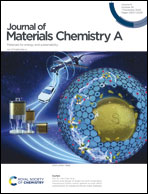An ultra-stable lithium plating process enabled by the nanoscale interphase of a macromolecular additive†
Abstract
Lithium metal batteries (LMB) are one of the most attractive candidates for next generation high energy density devices owing to the high specific capacity (3860 mA h g−1) and low electrochemical potential (−3.04 V vs. standard hydrogen electrode) of the lithium metal anode. However, a series of problems, especially lithium dendrite growth, hinder its commercial application and these issues are more prominent under extreme conditions. In this work, a novel nanostructured macromolecular lithium salt (LiMS) electrolyte additive, polyethylene glycol (PEG) tethered to partially lithiated SiO2 nanoparticles, is designed and synthesized. This organic–inorganic hybrid nanosized additive can not only serve as a flexible physical barrier between the Li/electrolyte interphase and provide extra Li+, but also absorb HF through some of its functional groups, thereby reducing the parasitic reactions that take place at high temperatures. Facilitated by the nanoscale protective layer formed by the LiMS additive, the Li‖Li4Ti5O12 battery demonstrates outstanding electrochemical performance within the wide temperature range of −20 to 60 °C. More than 70% of its theoretical capacity is delivered at −20 °C and 0.5C rate; 80.23% capacity is retained after 200 cycles under a critical condition of 5C and 60 °C. Moreover, the LiMS additive also improves the compatibility between the electrolyte and LiNi0.8Co0.1Mn0.1O2, thus demonstrating its potential for wide applications.



 Please wait while we load your content...
Please wait while we load your content...